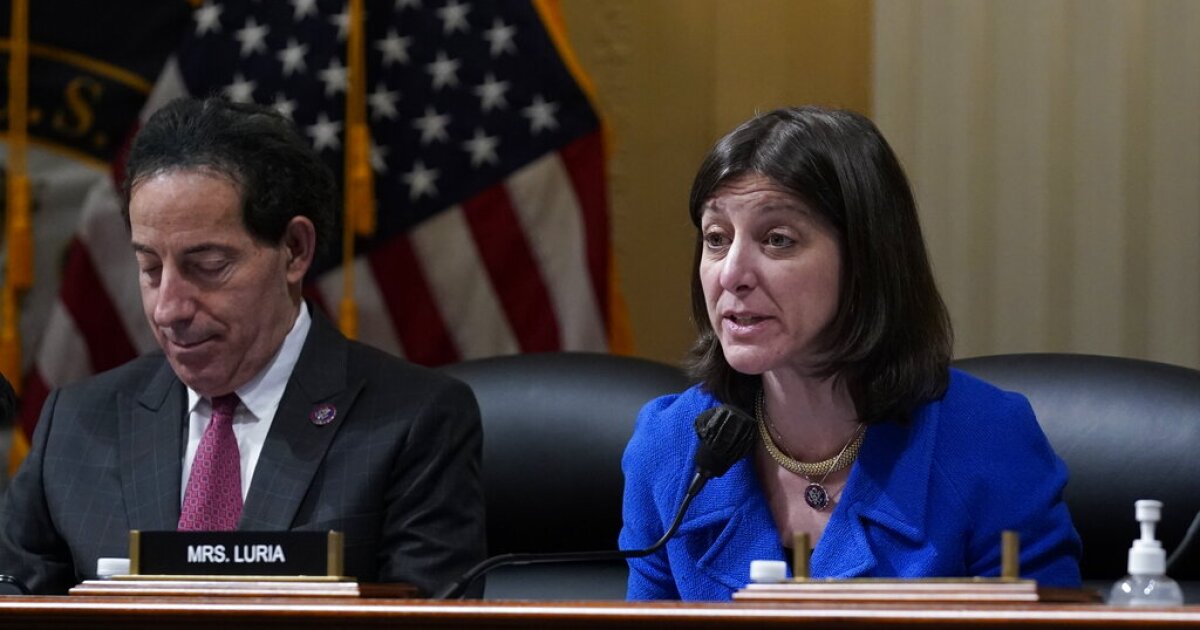

A member of the House Jan. 6 committee said investigators have “very few” records to show what former President Donald Trump was doing during the 187 minutes they report it took for him to urge rioters at the Capitol to go home.
The much-hyped period of time came up during a conversation with Rep. Elaine Luria (D-VA) on Sunday, when Meet the Press moderator Chuck Todd asked if the panel will introduce a “tick-tock” to demonstrate minute-by-minute what Trump was doing while a mob of people stormed the Capitol, disrupted the certification of the 2020 electoral votes, and threatened his vice president, Mike Pence.
“Well, I think it’d be more clear to describe it as what he was not doing. You know, it’s been reported previously that the phone logs at the White House on that date, they’re missing information,” the congresswoman said on NBC. “There is a gap there that we have tried, you know, through these witnesses, we’ve interviewed 1,000 witnesses and a lot of people who worked directly in the White House for the president in his immediate vicinity during that day.”
Investigators have “pieced together a very comprehensive tick-tock timeline of what he did,” added Luria, who then indicated what the committee knows is based more on witness testimony rather than documentation. “It’s a complex process to piece together. You know, you have 187 minutes, very few records,” she said.
JAN. 6 COMMITTEE CAN ‘PROVE’ TRUMP KNEW 2020 ELECTION WASN’T STOLEN, RASKIN SAYS
Rep. Liz Cheney (R-WY), the vice chairwoman of the Jan. 6 committee, declared back in December that Trump “refused to act” for exactly 187 minutes “when action by our president was required, it was essential, and it was compelled by his oath to our Constitution.” Cheney made the case for Trump’s “dereliction of duty” by reading text messages turned over to the committee by former White House chief of staff Mark Meadows in which all sorts of allies called for Trump to take action during the riot.
As noted by the Washington Examiner’s Byron York, Cheney’s 187 minutes was apparently the three hours and seven minutes between the portion of Trump’s speech to supporters on the Ellipse near the White House in which he called for his supporters to “peacefully” protest at the Capitol and the 4:17 p.m. video telling them to leave.
Still, during that period, Trump tweeted twice — once, at 2:38 p.m., saying, “Please support our Capitol Police and Law Enforcement. They are truly on the side of our Country. Stay peaceful!” and then, at 3:13 p.m., saying, “I am asking for everyone at the U.S. Capitol to remain peaceful. No violence! Remember, WE are the Party of Law & Order — respect the Law and our great men and women in Blue. Thank you!” Finally, at 4:17 p.m., Trump posted a video telling the rioters, “You have to go home now. We have to have peace. We have to have law and order.”
Months later, during the panel’s first prime-time hearing on Thursday, Cheney focused on a point in time nearly two hours later.
“At 6:01 p.m. on January 6th, after he spent hours watching a violent mob besiege, attack, and invade our Capitol, Donald Trump tweeted, but he did not condemn the attack. Instead, he justified it,” the congresswoman said. At 6:01 p.m. Trump tweeted, “These are the things and events that happen when a sacred landslide election victory is so unceremoniously & viciously stripped away from great patriots who have been badly & unfairly treated for so long. Go home with love & in peace. Remember this day forever!”
According to an NPR timeline of events, within the next hour, Facebook and Twitter began to take down Trump’s messages and suspend him from the platforms.
Chairman Bennie Thompson (D-MS) in December told the Washington Post, which reported his statement was based on interviews with witnesses and media reports, that it appeared Trump “tried to do a taping several times, but he wouldn’t say the right thing” at the White House. Even back then, the panel was open to recommending the Justice Department open a criminal investigation against Trump. “That dereliction of duty causes us real concern,” Thompson said. “And one of those concerns is that whether or not it was intentional, and whether or not that lack of attention for that longer period of time, would warrant a referral.”
In early January, Thompson stressed that it was imperative the committee gain access to more records to shore up what it knows about the storied 187-minute window. “If we’re successful — and we think we will be — we’re convinced that we will have access to those 187 minutes of whatever occurred,” Thompson told CNN, citing cases involving claims of executive privilege that made their way to the Supreme Court.
“The harm that I see is the president of the United States seeing the Capitol of the United States under siege by people he sent to the Capitol and did nothing during that time,” Thompson added. “Something’s wrong with that. So we need to find out who was calling, who was texting, who was emailing during those 187 minutes to see whether or not that information will let us know if people were part of the problem.”
Weeks later, the high court side with the Jan. 6 committee in this fight. However, certain people close to Trump have separately been resistant to cooperating with subpoenas from the Jan. 6 Committee, and the Washington Post reported in late March that the panel was investigating whether Trump communicated on Jan. 6 through back-channels, phones of aides, or burner phones after documents turned over by the National Archives showed a gap of seven hours and 37 minutes in the former president’s phone logs.
Going off what the committee has learned since last year, Luria said on Sunday investigators understand Trump never inquired about the health and safety of the vice president and also never talked with him during the riot. The congresswoman also declined to confirm whether Cassidy Hutchinson, an aide to then-White House chief of staff Meadows, is helping to piece together what happened in those 187 minutes.
CLICK HERE TO READ MORE FROM THE WASHINGTON EXAMINER
Hutchinson testified to the Jan. 6 committee behind closed doors that Trump suggested to Meadows that he approved of the “Hang Mike Pence” chants by rioters, according to CNN. Trump posted to Truth Social after the panel’s first prime-time hearing on Thursday, “I NEVER said, or even thought of saying, ‘Hang Mike Pence.'”
“Everyone who has come to speak to the committee that has direct evidence of that time-frame has been very helpful in piecing it together. I can’t say that there’s one person in particular,” Luria said.






